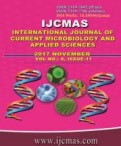


 National Academy of Agricultural Sciences (NAAS)
National Academy of Agricultural Sciences (NAAS)

|
PRINT ISSN : 2319-7692
Online ISSN : 2319-7706 Issues : 12 per year Publisher : Excellent Publishers Email : editorijcmas@gmail.com / submit@ijcmas.com Editor-in-chief: Dr.M.Prakash Index Copernicus ICV 2018: 95.39 NAAS RATING 2020: 5.38 |
Pulses are high value crops and generally greater attention is paid to protect them against diseases caused by microbial pathogens after harvest during storage. An extensive field survey was conducted in 203 Blocks of 31 districts comprising three agro-climatic zones of Uttar Pradesh during 2011-12 and 2012-13 to find out the status of soil borne pathogens and bioagents in major pulse growing areas. In case of phytopathogens, Fusarium sp., Rhizoctonia sp., Sclerotium rolfsii, Sclerotinia sclerotiorum, Phytophthora sp., Pythium sp., Colletotrichum sp, Aschochyta rabei, Alternaria sp., Pestalotiopsis sp. were found as major disease causing agents in all 3 agro-climatic zones of Uttar Pradesh. Bioagents like Trichoderma viride and Trichoderma harzianum were prevalent in most part of the survey area of Uttar Pradesh. Other bioagents in terms of prevalence were T. atroviride, T. ressei, T. asperellum, T. virens, T. longibrachiatum, T. koningii, T. citrinoviride, T. koningiopsis, T. aggressivum, T. aureoviride, T. erinaceum, T. pubscens, T. saturnisporum, T. tomentosum, T. minutisporum and T. spirale. Based on the survey, it was found that majority of soil borne pathogens are responsible for low yield of the pulse crops. Interestingly, it was noted that the fields having much prevalence of bioagents showed low infestation of wilt/ root rot diseases.
 |
 |
 |
 |
 |